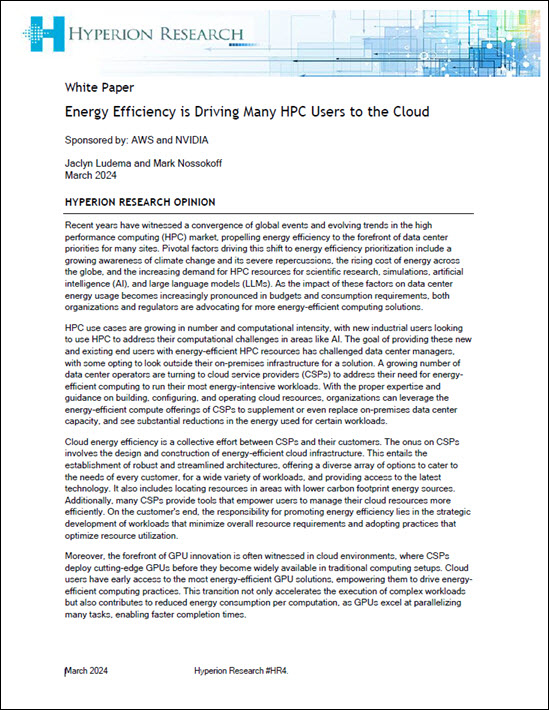[SPONSORED GUEST POST] The AMD HPC User Forum is holding a technical workshop prior to ISC High Performance on Sunday, May 12th, 2024, from 8:00AM – 12:00PM in Hamburg, Germany. The event will cover the AMD Instinct™ MI300 Series products, as well as the ROCm™ stack for HPC and AI. Space is limited and the event is open to all who would like to join ….
Lenovo and NVIDIA Partner on New Hybrid AI Solutions
[SPONSORED GUEST ARTICLE] Lenovo unveiled the expansion of its ThinkSystem AI portfolio designed for the most demanding AI, data analytics and HPC workloads, featuring two powerful 8-way NVIDIA GPU systems combining massive computational capabilities with power efficiency. Engineered for generative AI, the Lenovo systems incorporate support for the NVIDIA HGX AI supercomputing platform, including NVIDIA H100 and H200 Tensor Core GPUs and the new Grace Blackwell….
HPC News Bytes 20240408: Chips Ahoy! …and Quantum Error Rate Progress
A good April morning to you! Chips dominate the HPC-AI news landscape, which has become something of an industry commonplace of late, including: TSMC’s Arizona fab on schedule, the Dutch government makes a pitch to ASML, Intel foundry business’s losses, TSMC expands CoWoS capacity, SK hynix to investing in Indiana and Purdue, Quantinuum and Microsoft report 14,000 error-free instances
@HPCpodcast at GTC 2024: Taking in the Scene at Nvidia’s Week at the Center of the Tech World
Live from Nvidia’s GTC 2024 AI-everywhere show, Doug and Shahin get together in the usual coffee shop chat of the @HPCpodcast. We cover a wide range of announcements from Nvidia headlined by their new Blackwell GPU architecture, discuss the contrast between the Nvidia model and thoe of other players, and share some observations (including celebrity sitings and a stare-down between a dog and a robot….
HPC News Bytes 20240226: Intel Foundry Bash, Nvidia Earnings and AI Inference, HPC in Space, ISC 2024
A happy Monday of Leap Year Week to you! We offer a rapid run-through of the latest in HPC-AI, including: Intel Foundry bash, Gelsinger talks up the “Systems Foundry Era,” Wall Street hangs on Nvidia earnings, AI Training vs Inference, Digitial In-Memory Computing for inference efficiency, HPC in space, ISC 2024.
Exascale and Industry Innovation at GE Aerospace
Aug. 31, 2023 — GE Aerospace is partnering with French aerospace company Safran … on a next-generation technology demonstration program … that aims to reduce fuel consumption and CO2 emissions by 20 percent compared to today’s most efficient engine technologies. The high-fidelity modeling and simulation capabilities provided by exascale computing enable researchers ….
ETH Prof. Torsten Hoefler Joins CSCS as Chief Architect for Machine Learning
August 31, 2023 — As of Sept. 1, ETH Professor Torsten Hoefler will be chief architect for machine learning of the architecture and technology workgroup at the Swiss National Supercomputing Centre (CSCS). Hoefler has headed the Scalable Parallel Computing Laboratory (SPCL) at the Department of Computer Science at ETH Zurich since 2012.
Arm Introduces Neoverse Compute Subsystems
At Hot Chips today, Arm introduced the Arm Neoverse Compute Subsystems (CSS) designed to enable Arm users to build specialized silicon at lower cost, with less risk and faster time-to-market compared to discrete IP. Available today, Arm CSS N2 is a pre-integrated, PPA-optimized configuration of the Neoverse N2….
Sept. 8 Registration Deadline for October ALCF Hands-on HPC Workshop
Aug. 31, 2023 — The Argonne Leadership Computing Facility will hold Hands-on HPC Workshop on October 10-12, 2023 at the TCS Conference Center at Argonne National Laboratory. Deadline for registration is Friday, Sept. 8. Registration information can be found here. The workshop will provide hands-on time on Polaris and AI Testbeds focusing on porting applications […]













